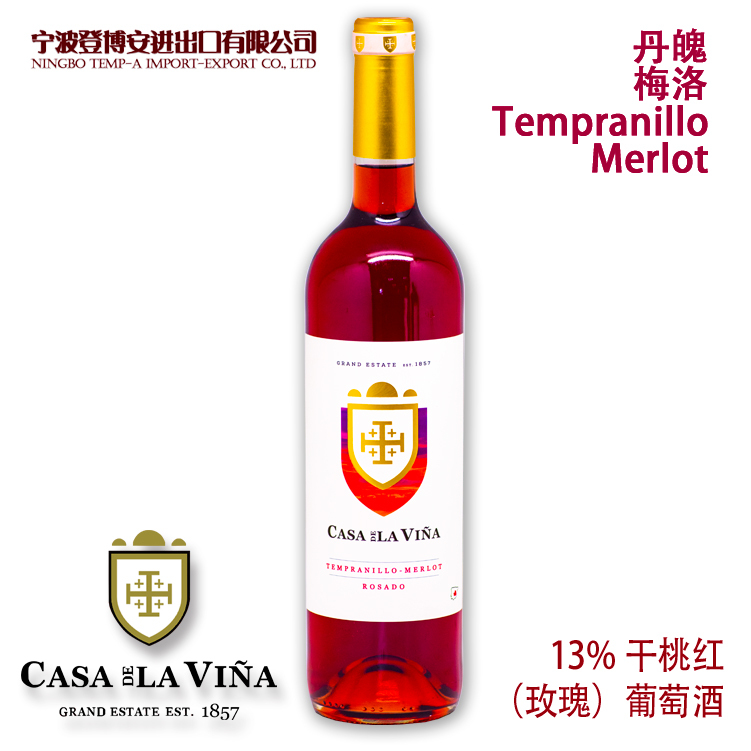- 产品详情
- 产品参数
- 产品评论
维纳庄园丹魄梅洛桃红(玫瑰)葡萄酒 TEMPRANILLO-MERLOT-CASA DE LA VINA
我们商店以最实惠的价格为您提供品类丰富的西班牙桃红葡萄酒

上桌温度serve themperature 8-10Co







CASA DE LAVIÑA 维纳庄园
Tempranillo·Merlot Rosado 丹魄·美乐 桃红葡萄酒
酿造工艺:
采用精选的丹魄和美乐-葡萄混合酿造。对于桃红葡萄酒的制作,需要通过重力引流来限制色素沉着,在这里所有的技术手段都得到了运用。在轻压和冷浸渍之后,必须在17摄氏度的容器中进行酒精发酵。这种方法确保从这些葡萄中获得**的水果香气。
品鉴:
酒体呈淡粉红色,圆润的边缘带有蓝色调,干净、明亮。具有强烈而细腻的成熟覆盆子的香气,伴有草莓的味道;回味具有鲜花和奶制品的芳香。初入口时,新鲜酸甜味在口中脱颖而出,可以感受到爽滑、清新和柔顺;在口中继续停留,则可感受浓郁的水果味。所以整个瓶中装载的是令人愉悦的水果记忆。
搭配:建议与海鲜、米饭、意大利面和轻口味的烤家禽搭配食用。
适饮温度: 10-12℃
Winemaking: Produced from. exclusivelyselected Tempranillo-Merlot grapes .
For the RoseitIs necessary to limit the pigmentation with only the drain by gravity.
In the elaboration of the Casa de la Vina Rose , all the technical elements are used. Thus, after a light crushing and cold maceration the must goes through a vessel at 17C where its alcohollc fermentation begins. This method ensures obtaining the maximum varietal aromas from these grapes.
Tasting notes: Pale pink with attractive subtle hues. Bright and clear . Remarkable yet delicate bouquet of ripe raspberry with hints of strawberry candy .
Subtle floral and lactic notes are perceived . Fresh yet full mouth - feel , relaying both youth and silkiness. Full fruit is sensed right through, and lingers on .
Serving advice: Best served at 10-12C with rice, fish, pasta and roasted poultry provided it is not very spicy .
HISTORY
 In 1789, Carlos V granted Pedro José PérezValiente a title of nobility. Nearly a century later, we find one of hisdescendants in Ciudad Real, the Count of Casavaliente, an old school landownerconverted into the greatest landowner of the province. Among his belongings,not only do we find Casa de la Viña, but also several surrounding hillsides andother nearby properties, making him the owner of a little kingdom of up to10.000 hectares of land.
In 1789, Carlos V granted Pedro José PérezValiente a title of nobility. Nearly a century later, we find one of hisdescendants in Ciudad Real, the Count of Casavaliente, an old school landownerconverted into the greatest landowner of the province. Among his belongings,not only do we find Casa de la Viña, but also several surrounding hillsides andother nearby properties, making him the owner of a little kingdom of up to10.000 hectares of land.
He was the one responsible for initiatingthe vine plantation at the property back in 1857 not with the goal ofelaborating wine himself but instead of selling the grapes to other winemakersof the region.
The current building, which houses thewinemaking facilities dates back two centuries as well. It is an old countryhouse of two stories with whitewashed walls, its noble wing made up of wideliving rooms which have presently been converted into offices, a tasting-room,and 15 bedrooms on the upper floor.
There is a little entrance porch which hasbeen converted into a brick arch with smooth lines, partially hidden behind anold elm-tree whose roots have formed undulations in the cobbled yard. In alittle granary nearby one can contemplate the 16 earthenware jars which servedas deposits for the conservation of wine a very long time ago. These taper atthe bottom and one can imagine how long ago the solid particles in the wineused to collect there.
The large inner patio, surrounded by oldstables, appears today empty and unaware of the hustle of old times, the noiseof  the cattle and the presence of labourers. Beyond the boundaries of the houseitself, one enters into open countryside, where at times the only trace ofmankind witnessed is the thought of how the skill of man has transformed thelandscape into a vast garden of vines and crops.
the cattle and the presence of labourers. Beyond the boundaries of the houseitself, one enters into open countryside, where at times the only trace ofmankind witnessed is the thought of how the skill of man has transformed thelandscape into a vast garden of vines and crops.
CURRENT SITUATION
Since the times of the Count ofCasavaliente, when the extent of land owned was as large as 4,000 hectares, theproperty passed through several hands up until it was bought by its currentowners, the SAT Anaypa. There was a time when the lands were hired out to theObregons, a family from Segovia that continued the tradition of cultivation ofvines. This tradition was carried on by its next owner, Angel Huertas, memberof a long lineage of winemakers from La Mancha. However, during this time, theagricultural exploitation of the land continued, but the grape was always soldafter harvesting, there was no wine production.
Eventually, after several phases, theplantation exceeded a million vines and at a cost of 125 million pesetas (inthe old currency). The winemaking, still small-scale, was initiated in the80's.
After the acquisition of the winery byBodegas y Bebidas in 1987, the company then went on to sell the vineyards in1996 to a long-standing agricultural family company, SAT Anaypa, which since,has continued to invest in improving the vineyards, now 40 years old and intheir prime of life as well as further restructuring and planting othervarietals.
The winery itself was sold to the DomecpGroup and then to Pernot-Ricard but eventually in 2010 SAT Anaypa managed toacquire the winery also and thus formed the equivalent of a chateau, a winerywith its own mansion situated within its estate.
Things started to change, when in the 70s,the then Bilbao Bank, acquired the property with the idea of creating a smallscale winery and took on the task of restructuring the vineyard, ripping androoting out old vines and initiating new plantations which would make it thegreatest single vineyard in Europe. The work took place at a frenetic pace;some 7,000 vines were planted daily in trellis instead of bush vines and spacedout at 3x2 metres, with a view towards using harvester machines from theoutset.
·历史
 1789年,西班牙国王卡洛斯五世授予佩德罗·何塞·佩雷斯·瓦伦特贵族称号。近一个世纪后,我们发现了他在雷阿尔城的一个后代——卡萨瓦利特伯爵。卡萨瓦利特伯爵是一片古老的土地所有者,也是当时该省**的土地所有者。在他的资产当中,我们发现了卡萨维纳庄园,包括周围的几座山坡和附近的其他房产,原来他是一个拥有10,000公顷土地的小王国的主人。
1789年,西班牙国王卡洛斯五世授予佩德罗·何塞·佩雷斯·瓦伦特贵族称号。近一个世纪后,我们发现了他在雷阿尔城的一个后代——卡萨瓦利特伯爵。卡萨瓦利特伯爵是一片古老的土地所有者,也是当时该省**的土地所有者。在他的资产当中,我们发现了卡萨维纳庄园,包括周围的几座山坡和附近的其他房产,原来他是一个拥有10,000公顷土地的小王国的主人。
早在1857年,他开始把自己的庄园开辟为葡萄种植园,但最初的目的不是自己酿造葡萄酒,而是把葡萄卖给该地区的其他酿酒师。
目前的建筑,其中容纳的酿酒设施可以追溯到两个世纪以前。这是一座两层楼的乡村别墅,宽阔的客厅组成像张开的两翼。墙壁重新粉刷,目前已改建为办公室、品酒室和楼上15间卧室。有一个小入口门廊,已经转换成一个砖拱门,一棵老树的根在鹅卵石院子里形成起伏。在附近的一个小粮仓里,有16个陶罐,这是很久以前人们用来保存葡萄酒的。这些陶罐底部呈锥形,以便葡萄酒中的固体颗粒在底部沉淀。被旧马房包围的内部天井,今天显得空荡荡的,很难想象出旧时代的这里曾经人声鼎沸和牛马嘶鸣。越过房子的边界,进入开阔的乡村,在这里你只会惊叹,人类的技能是如何把大自然的景观变成一个巨大葡萄庄园的。
·现状
自卡萨瓦利特伯爵时代以来,庄园土地面积在4 000公顷规模时,经过几手转卖,最终被其现任所有者SAT Anaypa买下。其中一次,土地被租给奥布雷贡人,一个来自塞戈维亚的家庭,延续了葡萄种植的传统。这个传统被下一任所有者安吉尔·韦尔塔斯所保持,他是来自拉曼恰酿酒师家族中的一员。在此期间,虽然庄园土地不断开垦,但葡萄总是收获之后就出售,没有酿造葡萄酒。
事情开始改变是在70年代,当时的毕尔巴鄂银行有收购资产的想法,打算创建一个规模化的酒厂,并重组葡萄园,淘汰旧葡萄树和启动新的种植园,打造成为当时欧洲**的单一葡萄园。这项工作以狂热的速度进行,每天约有7,000株葡萄树种植在棚架中,而且不是灌木藤蔓,并间隔在3x2米处,以期从一开始就使用收割机采摘。
最终,经过几个阶段开发,种植园的葡萄树超过100万株,耗资1.25亿比塞塔(以西班牙旧货币计算)。规模化的酿酒,开始在80年代出现。
1987年博德加斯和贝比达斯收购酒厂后,该公司于1996年将葡萄园出售给一家长期从事农业的家族企业SAT Anaypa,该公司此后继续投资改善葡萄园,如今的葡萄藤已有40年树龄,正处在黄金时期,庄园仍在进行进一步的重组和种植其他品种。酒厂本身则被出售给多美加集团,然后出售给Pernot-Ricard,但最终在2010年SATAnaypa设法收购了酒厂,从而形成了一个城堡,一个酒庄与豪宅的结合。
INTRODUCE VIDEO FROM WINE EXIBITION
介绍从欧洲国际展会


